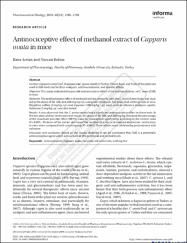| dc.contributor.author | Arslan, Rana | |
| dc.contributor.author | Bektaş, Nurcan | |
| dc.date.accessioned | 2019-10-19T14:16:23Z | |
| dc.date.available | 2019-10-19T14:16:23Z | |
| dc.date.issued | 2010 | |
| dc.identifier.issn | 1388-0209 | |
| dc.identifier.issn | 1744-5116 | |
| dc.identifier.uri | https://dx.doi.org/10.3109/13880201003629323 | |
| dc.identifier.uri | https://hdl.handle.net/11421/13144 | |
| dc.description | WOS: 000283406600016 | en_US |
| dc.description | PubMed ID: 20819022 | en_US |
| dc.description.abstract | Context: Capparis ovata Desf. (Capparaceae) grows widely in Turkey. Flower buds and fruits of the plant are used in folk medicine for their analgesic, antirheumatismal, and diuretic effects. Objective:This study evaluated the possible antinociceptive effect of the methanol extract of C. ovata (CME) in mice. Materials:The antinociceptive effect of methanol extract, prepared with the C. ovata flower buds, was studied at the doses of 50, 100, and 200 mg/kg (i.p.) using tail-immersion, hot-plate, and writhing tests in mice. Morphine sulfate (5 mg/kg; i.p.) and dipyrone (100 mg/kg; i.p.) were used as reference analgesic agents. Naloxone (5 mg/kg; i.p.) was also tested. Results: It was observed that the C. ovata extract had a significant antinociceptive effect in these tests. In the hot-plate and tail-immersion test results, the doses of 50, 100, and 200 mg/kg increased the percentage of the maximum possible effect (MPE%) value for nociception significantly according to the control value (P < 0.001). All doses of the extract decreased the number of acetic acid-induced abdominal constrictions in mice when compared with control group (P < 0.001). These effects were inhibited by pretreatment with naloxone. Discussion and conclusion: Based on the results obtained, it can be concluded that CME is a potentially antinociceptive agent which acts as both at the peripheral and central levels. | en_US |
| dc.language.iso | eng | en_US |
| dc.publisher | Taylor & Francis LTD | en_US |
| dc.relation.isversionof | 10.3109/13880201003629323 | en_US |
| dc.rights | info:eu-repo/semantics/openAccess | en_US |
| dc.subject | Antinociception | en_US |
| dc.subject | Capparis Ovata | en_US |
| dc.subject | Hot-Plate | en_US |
| dc.subject | Tail-Immersion | en_US |
| dc.subject | Writhing Test | en_US |
| dc.title | Antinociceptive effect of methanol extract of Capparis ovata in mice | en_US |
| dc.type | article | en_US |
| dc.relation.journal | Pharmaceutical Biology | en_US |
| dc.contributor.department | Anadolu Üniversitesi, Eczacılık Fakültesi, Farmakoloji Anabilim Dalı | en_US |
| dc.identifier.volume | 48 | en_US |
| dc.identifier.issue | 10 | en_US |
| dc.identifier.startpage | 1185 | en_US |
| dc.identifier.endpage | 1190 | en_US |
| dc.relation.publicationcategory | Makale - Uluslararası Hakemli Dergi - Kurum Öğretim Elemanı | en_US |
| dc.contributor.institutionauthor | Arslan, Rana | |
| dc.contributor.institutionauthor | Bektaş, Nurcan | |


















